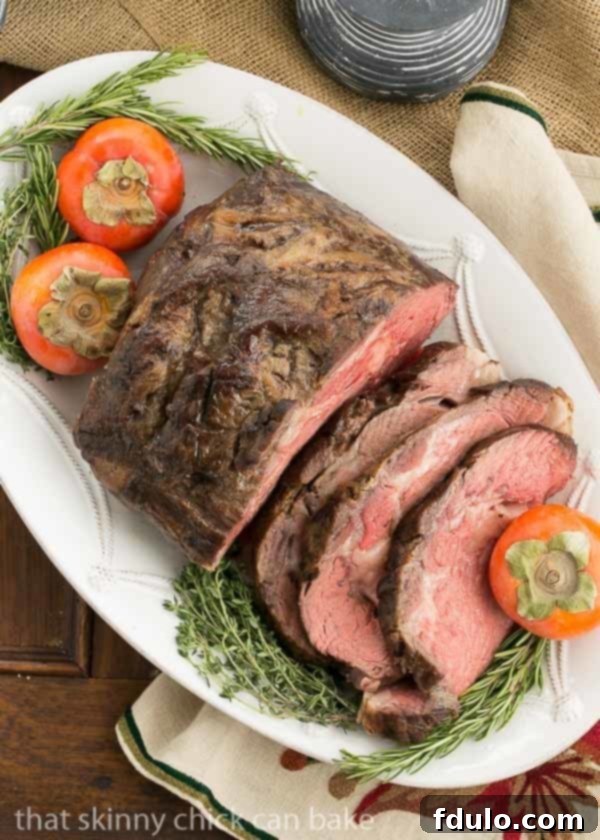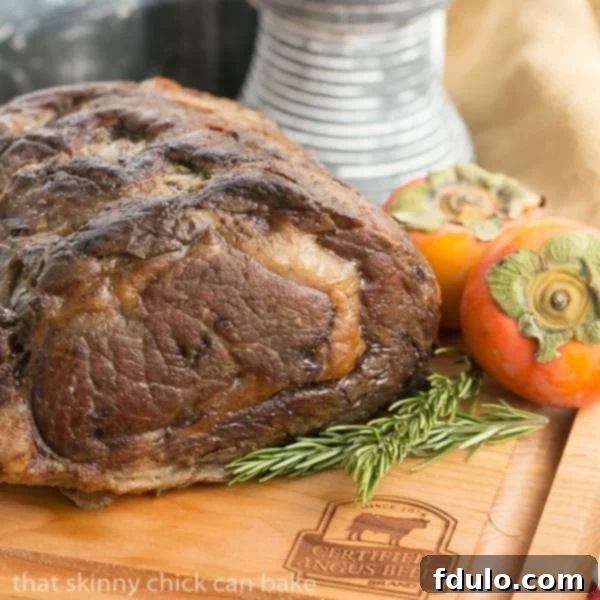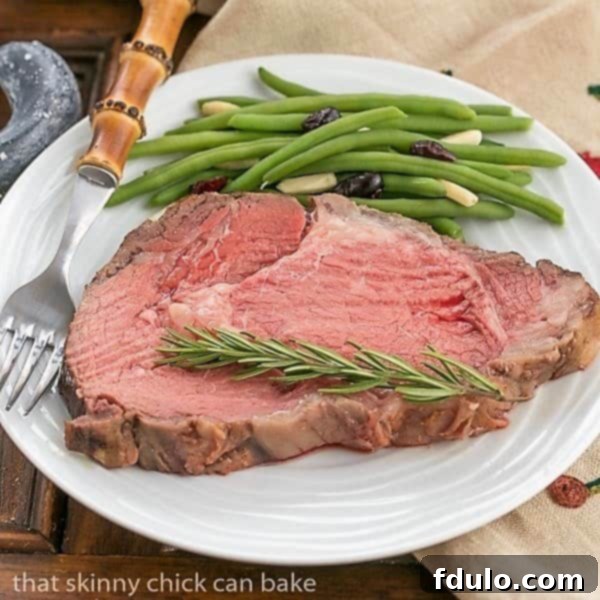Classic Prime Rib Roast: Your Foolproof Guide to a Restaurant-Quality Holiday Dinner
Prepare to impress your family and dinner guests with this truly spectacular Classic Prime Rib Roast. Often considered the crown jewel of holiday meals, prime rib doesn’t have to be intimidating. This foolproof recipe, honed over years, guarantees a tender, juicy roast that cooks perfectly every single time, leaving everyone swooning over its rich flavor and exquisite texture. Say goodbye to guesswork and hello to a culinary triumph!

Why This Classic Prime Rib Roast is a Must-Make
There are countless reasons why this Classic Prime Rib Roast recipe should be at the top of your list for any special occasion, especially during the festive holiday season:
- The Epitome of Holiday Feasting: Prime Rib is synonymous with celebration. It’s the ultimate centerpiece for your Christmas dinner, Thanksgiving feast, or any significant gathering, instantly elevating the dining experience.
- A Reliable Recipe for a Prized Cut: Investing in a prime rib roast is an investment in flavor and luxury. Given its higher price tag, you need a recipe you can trust to deliver exceptional results without the risk of overcooking. This proven method ensures your investment pays off with a perfectly cooked roast.
- Effortlessly Feeds a Crowd: A magnificent 7-rib prime rib roast can comfortably serve 10 or more people, making it an ideal choice for entertaining larger groups without having to prepare multiple dishes.
- Unforgettable Flavor and Tenderness: The techniques outlined in this guide, from dry brining to low-and-slow roasting, are designed to maximize the beef’s natural richness and ensure every bite is incredibly tender and bursting with savory goodness.
- Restaurant-Quality at Home: Achieve results that rival your favorite high-end steakhouse right in your own kitchen. With simple steps and a few key tools, you’ll create a meal that will leave a lasting impression.

Understanding and Selecting Your Prime Rib
Before diving into the cooking process, it’s essential to understand what prime rib is and how to select the best cut for your celebration.
What is Prime Rib?
Prime rib, also known as a standing rib roast, is a primal cut of beef from the rib section. It’s renowned for its rich marbling, tender texture, and incredible flavor. Interestingly, rib-eye steaks are cut from the same primal section. While a ribeye is cooked as an individual steak, a prime rib roast is cooked whole, allowing its magnificent flavor to develop fully.
How to Select the Best Prime Rib
Choosing the right prime rib is the first step towards a successful roast. Here’s what to look for:
- Number of Ribs/Weight: You can typically request a specific number of ribs or a desired weight. A good rule of thumb is to purchase about one pound of roast per person, keeping in mind that some of this weight includes the bone. Roasts can range from 2 to 7 ribs.
- “Prime” Quality vs. Prime Rib Name: Don’t be fooled by the name; “prime rib” refers to the cut, not always the USDA grade. If you truly want the highest quality beef, look for a “Prime” grade stamp, which indicates superior marbling and tenderness. Be prepared for this to be more expensive, usually reserved for very special occasions. “Choice” grade is also an excellent option, offering great flavor and tenderness at a more accessible price point.
- The Best Cut (Small End): According to culinary experts like Cook’s Illustrated, the best of the best comes from the loin end, also known as the small end or first cut (ribs 10-12). This section contains the desirable large, single rib-eye muscle, which is consistently uniform and exceptionally tender.
- Reputable Butcher: Always purchase your prime rib from a trusted butcher. They can provide insights into the beef’s origin, grade, and ensure you get a fresh, high-quality cut with excellent marbling. Good marbling—the white flecks of fat interspersed within the muscle—is crucial for a moist and flavorful roast.
Essential Preparation for a Flawless Roast
Achieving a restaurant-worthy prime rib begins long before it ever touches the oven. These crucial advance preparation steps are simple but make an enormous difference in the final taste and texture of your roast.
The Power of Dry Brining
For the absolute best flavor and tenderization, dry brine your prime rib roast 1 to 3 days before you plan to serve it. This process is incredibly easy and requires minimal effort:
- Score the Fat Cap: If your prime rib has a thick layer of fat on top (the fat cap), use a sharp knife to score it in a shallow crosshatch pattern. Be careful not to cut into the meat itself, only through the fat. This allows the salt and seasonings to penetrate more effectively and helps the fat render and crisp up beautifully during roasting.
- Generously Season: Rub the entire surface of the roast generously with kosher salt. Kosher salt crystals are larger than table salt, making them ideal for drawing out moisture and creating a flavorful crust.
- Air Age in the Refrigerator: Place the seasoned roast, uncovered, on a wire rack set over a baking sheet in your refrigerator. Leave it there for 1 to 3 days. The salt will work its magic through osmosis, penetrating the meat and enhancing its flavor while breaking down some proteins for tenderness. The exposure to air also helps to dry the exterior, promoting a superior crust during cooking.
PRO-Tip: Allow your dry-brined roast to sit at room temperature for about an hour before roasting. This helps remove the chill from the meat, ensuring more even cooking from edge to center.
Mastering the Low and Slow Roasting Technique
The secret to a perfectly cooked prime rib with a beautifully rare interior and a delectable, crispy exterior lies in the “low and slow” roasting method, followed by a final high-heat blast. This technique prevents overcooking the outer layers while gently bringing the center to your desired doneness.
Step-by-Step Cooking Guide
- Initial Sear (Optional but Recommended): For an even richer color and depth of flavor, consider searing the exterior of your prime rib in a small amount of hot oil in a sturdy roasting pan or large skillet for a couple of minutes on each side before roasting. This creates a delicious browned crust that enhances the overall appeal. While optional, it’s a chef’s trick for preventing a “gray” roast.
- Preheat Oven and Set Up: Preheat your oven to a low temperature, typically 200ºF (95ºC). Place the seared (or un-seared) prime rib on a rack inside a roasting pan. This elevates the roast, allowing hot air to circulate evenly around it.
- Insert Meat Thermometer: Crucially, insert an accurate meat thermometer into the thickest part of the roast, avoiding bone. This is the single most important tool for ensuring perfect doneness. We’re aiming for precision, not guesswork!
- The Low and Slow Cook: Roast the prime rib in the 200ºF (95ºC) oven for approximately 3-4 hours, or until the meat thermometer registers an internal temperature of 110ºF (43ºC). The exact timing will depend on the size and shape of your roast. The goal is to gently warm the entire roast through.
- Rest in the Oven (Carryover Cooking): Once the roast reaches 110ºF (43ºC), turn off the oven completely. Leave the roast inside, without opening the oven door, for about 30 minutes. During this period, residual heat will continue to cook the meat, slowly raising its internal temperature to approximately 120ºF (49ºC) for a perfect rare. For medium-rare, aim for 125-130°F (52-54°C). For medium, target 135-140°F (57-60°C). Remember, you can always cook longer, but you can’t reverse an overcooked roast!
- Remove and Rest (Foil Covered): After the carryover cooking in the oven, remove the roast and immediately cover it loosely with foil. Let it rest on a cutting board for another 10 to 30 minutes. This critical resting period allows the juices to redistribute throughout the meat, ensuring a moist and tender slice every time. Skipping this step can result in dry, less flavorful meat.
- Broil for a Crispy Finish: After resting, remove the foil. Turn on your oven’s broiler and place the prime rib underneath. Broil carefully, watching it constantly, until the top layer of fat is beautifully browned and crispy. This step creates that irresistible golden crust.
- PRO-Tip: Never leave the roast unattended under the broiler! Prime rib is an expensive cut of beef, and a few moments of inattention can lead to burning.
- Slice and Serve: Once the exterior is perfectly browned, remove the roast from the broiler. Carve the meat into desired slices. Season with additional salt and freshly ground black pepper if needed.
Following this method will yield a spectacular holiday entrée that your family will rave about. This Prime Rib Roast Recipe is truly designed for special occasions, promising rave reviews every time!

Expert Tips for Prime Rib Perfection
- Yorkshire Puddings: This is your prime opportunity to make Yorkshire puddings. They are a classic pairing with prime rib and traditionally use the rich beef fat drippings (instead of butter) to achieve their signature airy, crispy texture.
- Accurate Meat Thermometer: As emphasized, an accurate meat thermometer is non-negotiable for achieving your desired doneness, especially if you prefer your beef rare or medium-rare. It removes all doubt and ensures precision.
- Plan Ahead: While the cooking process itself is straightforward, the dry brining and resting require advance planning. Ensure your roast is defrosted and dry-brined 1-3 days ahead of time, and remember to let it come to room temperature for an hour before roasting.
- Garlic Infusion: For an extra layer of flavor, feel free to cut small slits into the fat cap and insert thin slices of fresh garlic before roasting. Alternatively, a sprinkle of garlic powder can also enhance the seasoning.
- Doneness Guide:
- Rare: 120-125°F (49-52°C)
- Medium-Rare: 130-135°F (54-57°C)
- Medium: 135-140°F (57-60°C)
- Medium-Well: 140-145°F (60-63°C)
- Well-Done: Not recommended for prime rib, as it will likely be dry and tough.

Frequently Asked Questions About Prime Rib
Prime rib and ribeye both come from the same primal cut of beef: the rib. The key difference lies in how they are prepared and cooked. A ribeye steak is a single steak cut from this section and then cooked individually, often grilled or pan-seared. Prime rib, or standing rib roast, is the entire primal cut (or a larger portion of it) roasted whole. Cooking the meat on the bone as a large roast allows for more even heat distribution and results in a richer, more profound flavor and juicier texture due to less surface area exposure and the insulating effect of the bone and fat.
Generally, you should plan on purchasing about one pound of prime rib per person. This accounts for the weight of the bone and any trimming. For smaller appetites or if serving many side dishes, 3/4 pound per person might suffice. If you prefer generous servings or want leftovers, aim for 1.25 pounds per person. A 7-rib roast typically weighs between 14-18 pounds and can comfortably feed 10-14 people.
The last thing you want to do is microwave your perfectly cooked, rare leftover prime rib, as it’s guaranteed to overcook and toughen it. Instead, preheat your oven to a low temperature, around 250°F (120°C). Place slices of prime rib in a baking pan with a splash of beef broth or water to keep them moist. Cover the pan tightly with foil and warm for about 10-15 minutes, or until just heated through. This gentle reheating method maintains the meat’s tenderness and prevents it from drying out.
Yes, you can purchase a “boneless” prime rib roast, often called a boneless ribeye roast. While the bone offers some insulation and flavor contribution during cooking, a boneless roast is easier to carve. Many butchers will remove the bones and tie them back to the roast for cooking, allowing you to enjoy the benefits of bone-in cooking while making carving simple.
Cooked prime rib leftovers, stored properly in an airtight container, will last for 3-4 days in the refrigerator. For longer storage, you can freeze sliced prime rib for up to 2-3 months. Thaw frozen prime rib in the refrigerator overnight before reheating.
Delicious Pairings and Related Recipes
Complete your prime rib experience with these complementary dishes or explore other incredible beef recipes:
- Garlic Crusted Prime Rib Roast by Life Tastes Good
- Gorgonzola Mushroom Stuffed Beef Tenderloin
- Bacon Wrapped Beef Tenderloin
- Beef Tenderloin with Gorgonzola Sauce
- Serve this roast with a creamy, zesty Horseradish Sauce for the ultimate flavor combination.
- Explore more delightful Beef Recipes for every occasion.
Stay in touch and share your culinary creations! Find me on Instagram, Facebook, and Pinterest. Don’t forget to tag me when you try one of my recipes! If you love the results, please consider leaving a 5-star rating in the recipe card below.

Classic Prime Rib
10 minutes
4 hours
4 hours 10 minutes
8
A simple yet, outstanding recipe for prime rib adapted from Cook’s Illustrated
Ingredients
- 6-pound Certified Angus Beef® Brand prime rib roast (ribs removed)
- 2 tablespoons kosher salt
- Freshly ground black pepper
- Oil, to sear roast
Instructions
- One to 3 days before serving, cut slits into fat on top of the roast in a crosshatch pattern. Rub salt all over the roast, and refrigerate uncovered.
- On serving day, preheat the oven to 200º F.
- Sear roast in a roaster in a small amount of oil, a couple of minutes on each side.
- Place rack into the roaster, and set beef on a rack. Place in the oven and insert a meat thermometer into the center of the roast.
- Cook for 3-4 hours till the meat thermometer registers 110º.
- Turn the oven off and let rest for about 30 minutes without opening the oven door. Remove when internal temperature reaches about 120º for rare.
- Cover roast with foil and wait at least 10 and up to 30 minutes to let juices redistribute.
- Uncover, and place under broiler and broil till top is browned and crispy, watching carefully to prevent burning.
- To serve, cut meat into slices. Season with additional salt if necessary.
Notes
Feel free to cut some slits in the top of the roast and insert some slices of garlic before roasting. Or sprinkle with garlic powder.
Note that total time does not include dry brining time.
Recommended Products
As an Amazon Associate and member of other affiliate programs, I earn from qualifying purchases.
- Kosher Salt
- Thermapen Instant Read Thermometer
- Roasting Pan
Nutrition Information:
Yield:
8
Serving Size:
1
Amount Per Serving:
Calories: 1074Total Fat: 74gSaturated Fat: 29gTrans Fat: 0gUnsaturated Fat: 35gCholesterol: 318mgSodium: 1813mgCarbohydrates: 0gFiber: 0gSugar: 0gProtein: 96g
Calories include all visible fat.
HOW MUCH DID YOU LOVE THIS RECIPE?
Please leave a comment on the blog or share a photo on Pinterest
